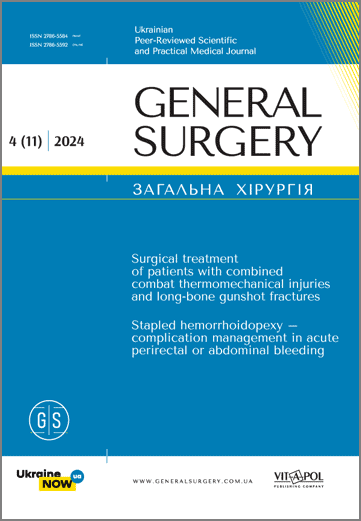The role of clinical and genealogical study in the examination of patients with chronic venous insufficiency
DOI:
https://doi.org/10.30978/GS-2024-4-50Keywords:
varicose disease, chronic venous insufficiency, reticular varicose veins, clinical and genealogical studyAbstract
Objective — to demonstrate the role of heredity in the development of varicose veins using a clinical‑genealogical study, analyze family cases of varicose veins of the lower extremities, determine the type of disease inheritance in the examined patients, and assess the possible outcomes of genetic inheritance for their descendants.
Materials and methods. The study involved 64 patients, mostly women — 52 (81.3%), with different clinical classes of varicose veins. The clinical‑genealogical method of pedigree analysis was used to establish the type of inheritance. We determined the nature of the disease trait (hereditary or non‑hereditary) and the type of inheritance (autosomal dominant, autosomal recessive, or gender‑linked).
Results. Among the 64 examined patients, 28 (43.8%) had familial cases of varicose veins. In our clinical‑genealogical study of the pedigrees of patients with chronic venous insufficiency, we found an autosomal dominant inheritance of this pathology, not linked to gender. Direct inheritance across generations was observed.
Conclusions. The analysis of the pedigrees of patients with varicose veins of the lower extremities and other manifestations of chronic venous insufficiency revealed the familial nature of disease inheritance, characterized by an autosomal dominant inheritance type and a high degree of gene expression. In these families, children are more likely to show signs of the disease. A hereditary predisposition to certain forms of varicose veins has also been noted. Consequently, in individuals with reticular varicose veins, the main veins of the lower extremities exhibited no alterations with age, whereas reticular varicose veins simply increased in prevalence.
References
Ahmed WU, Kleeman S, Ng M, Wang W, Auton A; 23andMe Research Team; Lee R, Handa A, Zondervan KT, Wiberg A, Furniss D. Genome-wide association analysis and replication in 810,625 individuals with varicose veins. Nat Commun. 2022 Jun 2;13(1):3065. http://doi.org/10.1038/s41467-022-30765-y. PMID: 35654884; PMCID: PMC9163161.
Antani MR, Dattilo JB. Varicose Veins. 2023 Aug 8. In: StatPearls [Internet]. Treasure Island (FL): StatPearls Publishing; 2024 Jan–. PMID: 29262112.
Aslam MR, Muhammad Asif H, Ahmad K, et al. Global impact and contributing factors in varicose vein disease development. SAGE Open Med. 2022 Aug 25;10:20503121221118992. http://doi.org/10.1177/20503121221118992. PMID: 36051783; PMCID: PMC9425889.
Carpentier PH, Maricq HR, Biro C, Ponçot-Makinen CO, Franco A. Prevalence, risk factors, and clinical patterns of chronic venous disorders of lower limbs: a population-based study in France. J Vasc Surg. 2004;40:650-9.
Fukaya E, Flores AM, Lindholm D, Gustafsson S, Zanetti D, Ingelsson E, Leeper NJ. Clinical and genetic determinants of varicose veins. Circulation. 2018 Dec 18;138(25):2869-80. http://doi.org/10.1161/CIRCULATIONAHA.118.035584. PMID: 30566020; PMCID: PMC6400474.
Hirai M, Naiki K, Nakayama R. Prevalence and risk factors of varicose veins in Japanese women. Angiology. 1990;41:228-232.
Ho TV, Chowdhury N, Kandl C, Hoover C, Robinson A, Hoover L. Genealogical databases as a tool for extending follow-up in clinical reviews. Int Forum Allergy Rhinol. 2016 Aug;6(8):880-2. http://doi.org/10.1002/alr.21744. Epub 2016 Mar 25. PMID: 27013063.
Korolova K, Teplyi V. A genetic study of patients with chronic venous insufficiency based on clinical and genealogical method. Med Sci of Ukr. [Internet]. 2018Jun.21;14(1-2):59-3. https://doi.org/10.32345/2664-4738.1-2.2018.09.
MacColl E, Khalil RA. Matrix metalloproteinases as regulators of vein structure and function: implications in chronic venous disease. J Pharmacol Exp Ther. 2015;355(3):410-28. https://doi.org/10.1124/jpet.115.227330.
Mao C, Ma Z, Jia Y, et al. Nidogen-2 maintains the contractile phenotype of vascular smooth muscle cells and prevents neointima formation via bridging Jagged1-Notch3 signaling. Circulation. 2021 Oct 12;144(15):1244-61. http://doi.org/10.1161/CIRCULATIONAHA.120.053361. Epub 2021 Jul 28. PMID: 34315224.
Rabe E, Berboth G, Pannier F. Epidemiologie der chronischen Venenkrankheiten [Epidemiology of chronic venous diseases]. Wien Med Wochenschr. 2016 Jun;166(9-10):260-3. German. doi: 10.1007/s10354-016-0465-y. Epub 2016 Jun 8. PMID: 27277219.
Serra R, Buffone G, de Franciscis A, et al. A genetic study of chronic venous insufficiency. Ann Vasc Surg. 2012 Jul; 26(5):636-42. https://doi.org/10.1016/j.avsg.2011.11.036.
Suda T, Katagiri A, Fujii H. Klippel-Trenaunay syndrome. Intern Med. 2023 May 1;62(9):1377-8. http://doi.org/10.2169/internalmedicine.0251-22. Epub 2022 Sep 28. PMID: 36171122; PMCID: PMC10208789.
Downloads
Published
How to Cite
Issue
Section
License
Copyright (c) 2025 Authors

This work is licensed under a Creative Commons Attribution-NoDerivatives 4.0 International License.






